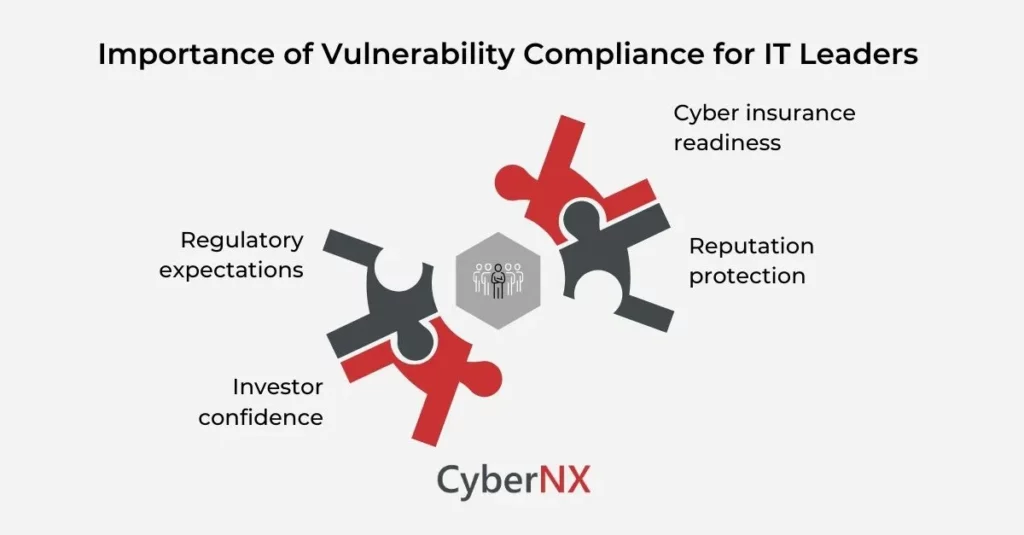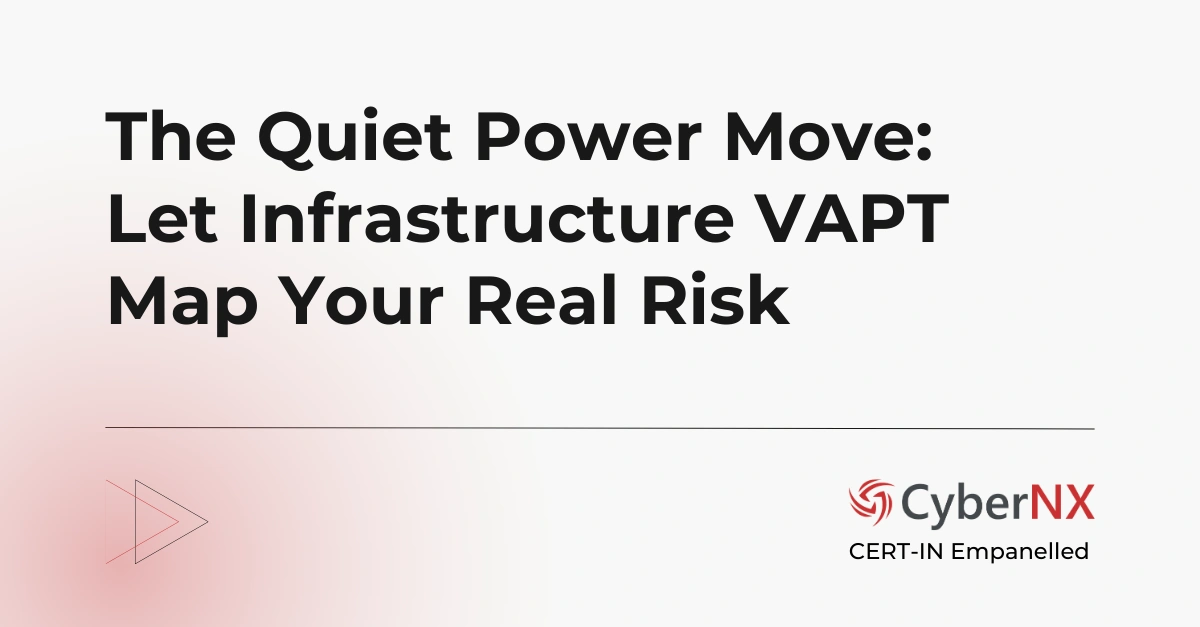Businesses today must operate in the digital environment. This is an inescapable reality. However, what it has done is to increase digital threats that could disrupt operations. To manage and mitigate this modern and now perennial risk, vulnerability compliance is important. This means companies need to meet legal as well as industry-specific compliance requirements.
There is another facet to vulnerability compliance. Businesses need to be secure and prove that they are secure. Customers, investors, regulators and insurers – all demand assurances. That vulnerabilities are tracked; they are remediated and documented too. That assurance is vulnerability compliance. Without it, even the most diligent patching effort looks like improvisation instead of governance.
What is Vulnerability Compliance?
By definition, vulnerability compliance is the process of managing vulnerabilities. This is done according to the defined standards, existing policies and frequently updated regulatory requirements. What it does? Vulnerabilities get identified, resolved and documented within acceptable timelines and with clear evidence to back it up.
Think of it as the accountability framework around your vulnerability program. Where detection and remediation are the mechanics, compliance is the proof. It ties every action back to policy, service-level agreements (SLAs) and external obligations, leaving a traceable record of responsibility.
Why Vulnerability Compliance Matters for IT Leaders
Because vulnerability compliance is a business enabler. Here are other reasons why it matters:
Benefits of Vulnerability Compliance
Treating vulnerability compliance as a strategic discipline delivers measurable advantages:
- Audit-readiness at all times: Imagine how much audit-readiness at all times can ease the burden off security leaders. This is possible with vulnerability assessment where evidence is built into day-to-day operations.
- Operational consistency: When you strictly follow compliance frameworks, you essentially eliminate finger-pointing. This is because it is clearly defined who owns remediation, approvals and exceptions.
- Better risk decisions: Documentation of exceptions enabled, and achievable timelines give leaders a clear and a crystal clear picture of residual risks. How it helps? Well, it makes smarter decisions possible.
- Improved trust and credibility: Overall, customers, associates and partners feel safer when you can prove compliance with industry standards. This is especially true in BFSI and healthcare industries.
- Reduced financial and legal exposure: When you are capable of demonstrating compliance, it automatically lowers the risk of fines, penalties and denied insurance claims.
The Core Elements of Vulnerability Compliance
Many security-oriented companies build effective and efficient vulnerability compliance programs. According to our research and experience, organisations should focus on these four key elements:
1. Policy Definition
A written cybersecurity policy that sets the rules. It should mandate scan frequency, remediation timelines (E.g. critical issues fixed within 15 days), exception handling and reporting cadence.
2. Evidence and Audit Trail
Every fix, exception or acceptance of risk must be logged. Audit trails show when vulnerabilities were identified, how they were addressed and who approved exceptions.
3. Continuous Monitoring
Compliance shouldn’t be one-time effort. When you do ongoing checks. it ensures vulnerabilities are handled consistently and deviations are flagged quickly.
4. Reporting and Metrics
Dashboards and vulnerability compliance reports translate technical details into executive insights: SLA adherence, open exceptions and compliance trends over time.
How to Build a Strong Vulnerability Compliance Program
Here’s a practical roadmap business leaders can adopt:
1. Define the Standard
Start with a simple, enforceable policy – remediation timelines, escalation paths, and exception approval workflows.
2. Integrate Compliance into Daily Operations
Don’t treat it as a parallel process. Compliance must sit within ticketing systems, patch management, and change control.
3. Automate Evidence Capture
Use tools that automatically generate logs, reports, and compliance dashboards. This removes reliance on manual spreadsheets.
4. Establish Clear Accountability
Identify who signs off on exceptions, who monitors SLAs, and who reports compliance to executives.
5. Review and Adapt
Regularly revisit compliance rules to reflect evolving regulatory requirements and business risk appetite.
Common Pitfalls to Avoid
Even mature organisations stumble when implementing vulnerability compliance. The most common missteps include:
- Treating compliance as a once-a-year audit exercise instead of continuous discipline.
- Focusing on raw vulnerability counts rather than whether issues were resolved in compliance with policy.
- Ignoring exception management, leading to “temporary” exceptions becoming permanent risks.
- Overcomplicating reports, making it impossible for executives to understand or act on them.
Common Compliance Vulnerabilities
Even organisations with solid vulnerability programs often stumble on the compliance side. Here are the most common gaps that derail vulnerability compliance:
- Missed SLA deadlines: Critical vulnerabilities linger beyond policy timelines because of patching delays, change-control bottlenecks, or resource shortages.
- Incomplete asset coverage: Shadow IT, cloud sprawl, and forgotten endpoints lead to blind spots. If a system isn’t being scanned, compliance reporting is automatically flawed.
- Poor exception handling: Teams approve “temporary” risk acceptances without expiration dates or reviews, creating silent, long-term non-compliance.
- Lack of audit-ready evidence: Remediation may happen, but without logs, tickets, or reports, organisations can’t prove it to auditors or regulators.
- Overreliance on raw vulnerability counts: Chasing volume instead of SLA adherence and risk prioritisation misrepresents compliance status. The number that matters is timely closure, not total findings.
Addressing these vulnerabilities early helps leadership maintain confidence that compliance efforts are credible, consistent, and defensible.
Signs You’re Getting Vulnerability Compliance Right
You know your program is working when leadership can answer – with evidence – these questions at a moment’s notice:
- Are there any critical vulnerabilities older than our defined SLA?
- Can we show remediation tickets and closure dates?
- Have exceptions been logged, approved, and reviewed?
- Are compliance metrics reported to executives and auditors regularly?
If the answer to all of these is “yes,” then vulnerability compliance has moved from being a technical chore to a business-strengthening discipline.
Conclusion
Security leaders today are under immense pressure. But you can prove control, governance and responsibility with vulnerability compliance.
When you define policies, capture evidence and report consistently, organisations will satisfy regulators, reassure stakeholders and build resilience. Vulnerability compliance builds confidence. And in a world where trust is currency, right vulnerability assessment service provider can further strengthen your cybersecurity. Contact us today for vulnerability assessment services.
Vulnerability Compliance FAQs
Is vulnerability compliance mandatory for all industries?
Not always, but heavily regulated sectors like BFSI, healthcare, and fintech face strict compliance requirements. For others, it’s a best practice that strengthens trust and reduces insurance or legal risks.
How often should vulnerability compliance be reviewed?
At least quarterly for policy and SLA alignment but reporting and monitoring should be continuous. Reviews should also follow major regulatory changes or security incidents.
Can vulnerability compliance be outsourced?
Yes. Many organisations partner with cybersecurity providers who offer compliance monitoring, evidence reporting, and audit support. Outsourcing reduces operational overhead but still requires internal accountability.
What happens if we fail a vulnerability compliance audit?
Consequences can include regulatory fines, higher cyber insurance premiums, loss of certifications, or erosion of customer trust. In some industries, non-compliance may also restrict your ability to operate.






